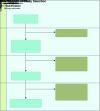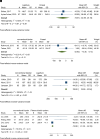Electrosurgical Devices Used During Laparoscopic Hysterectomy
- PMID: 39749228
- PMCID: PMC11694779
- DOI: 10.4293/JSLS.2024.00022
Electrosurgical Devices Used During Laparoscopic Hysterectomy
Abstract
Background: Hysterectomy is one of the most common surgical procedures performed in the United States and most are now being performed in a minimally invasive approach. Electrosurgery and vessel sealing devices are needed in order to provide hemostasis and vascular coaptation; however, there is no guiding evidence and limited recommendations for the use of the currently available devices for laparoscopic hysterectomy. The purpose of this study is to provide a systematic review of electrosurgical devices used in benign hysterectomy and perform a meta-analysis to find the overall effect of various outcomes.
Database: A systematic review was performed by searching the literature using MEDLINE, Embase, Cochrane Central Register of Controlled Trials, and the Cochrane Database of Systematic Review, Science Citation Index Expanded, Emerging Sources Citation Index, Scopus, Epistemonikos, and SciELO databases from each database's inception date until May 2023.
Conclusion: Advanced bipolar vessel sealing devices demonstrate reduced blood loss and operative times when compared to conventional electrosurgery, however more high-quality evidence and cost analysis is needed to strengthen the clinical significance of these findings.
Keywords: Advanced bipolar vessel sealing device; Electrosurgery; Gynecology; Laparoscopy; Minimally invasive gynecologic surgery; Ultrasonic device.
© 2024 by SLS, Society of Laparoscopic & Robotic Surgeons.
Conflict of interest statement
Conflict of interests: none.
Figures







References
Publication types
MeSH terms
LinkOut - more resources
Full Text Sources
Medical
